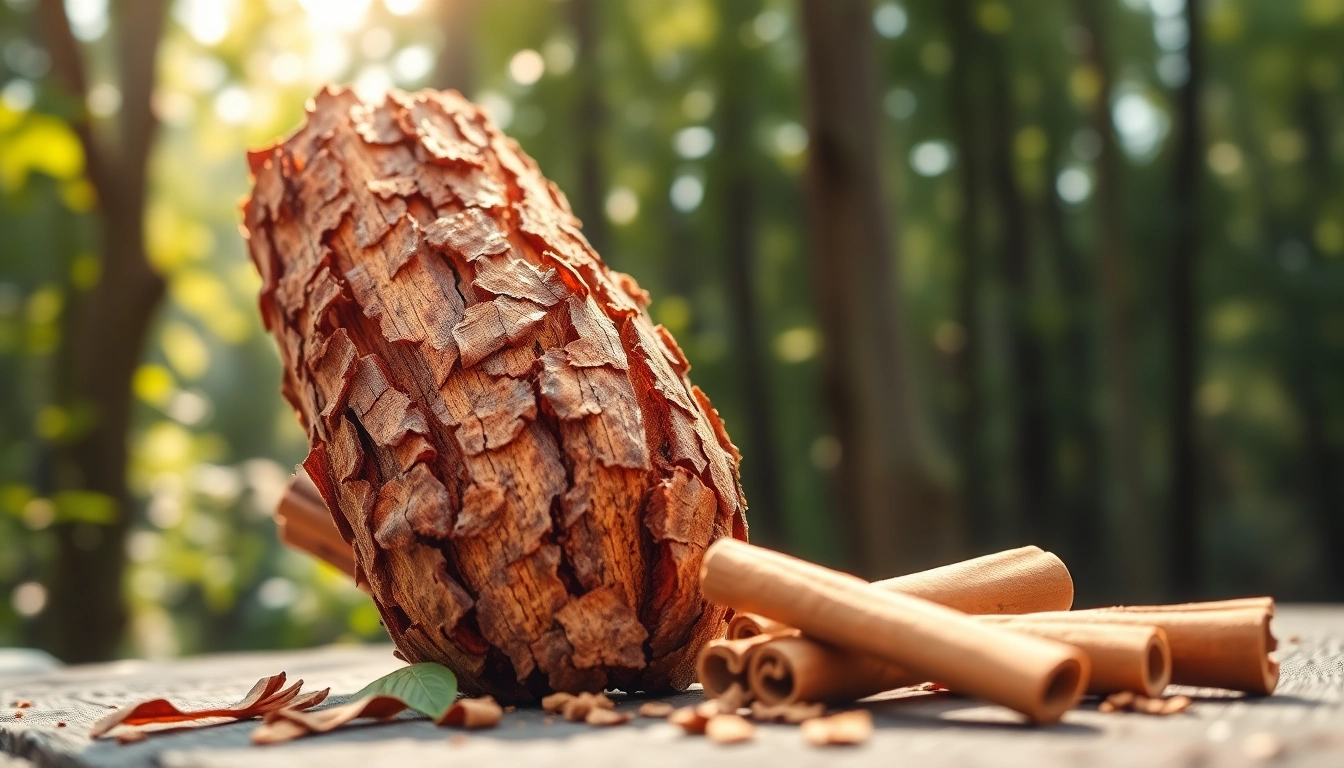Understanding Cinnamon Bark: A Flavorful Heritage
What is Cinnamon Bark?
Cinnamon bark is the inner bark obtained from trees of the genus Cinnamomum, native to Sri Lanka, India, and Southeast Asia. It is widely recognized for its aromatic and flavorful properties, making it a staple not only in culinary traditions but also in traditional medicine. The term “cinnamon” often refers to two major varieties: Ceylon cinnamon (Cinnamomum verum) and Cassia cinnamon (Cinnamomum cassia), with the former being more prized for its quality and health benefits. The bark possesses a warm, sweet, and woody flavor, which enhances both sweet and savory dishes alike.
History and Origin of Cinnamon Bark
The history of cinnamon dates back thousands of years and spans across various cultures. Ancient Egyptians used cinnamon for embalming, while it found a place in numerous religious rituals. In ancient China, it was recognized for its medicinal properties. By the Middle Ages, cinnamon became a prized spice in Europe, often used as a status symbol, with trade routes established to facilitate its movement. Its value led to a variety of myths and tales, including beliefs that it was harvested from the nests of mythical birds. Today, countries like Indonesia and Vietnam are also significant producers of cinnamon, influencing the global spice trade.
Cinnamon Bark vs. Other Cinnamon Varieties
When discussing cinnamon bark, it is essential to differentiate between the two primary varieties: Ceylon cinnamon, often called “true cinnamon,” and Cassia cinnamon. Ceylon cinnamon has a lighter, more delicate flavor and a higher concentration of beneficial compounds, while Cassia cinnamon is more robust and sweet but may contain higher levels of coumarin, which can be harmful in large quantities. Therefore, for health-conscious consumers, choosing the right type of cinnamon bark is crucial.
Health Benefits of Cinnamon Bark
Nutritional Profile of Cinnamon Bark
Cinnamon bark is not just a flavorful spice; it also boasts an impressive nutritional profile. It’s rich in polyphenols, which are antioxidants that help protect the body from oxidative stress. Per teaspoon, Ceylon cinnamon offers the following nutrients: calories (6), carbohydrates (2 g), fiber (1 g), and essential oils. These components contribute to metabolic health, heart health, and can even enhance cognitive function.
Potential Medicinal Uses of Cinnamon Bark
Research indicates that cinnamon bark may have several medicinal applications. It has been linked to lowering blood sugar levels, which is particularly important for individuals with diabetes. Cinnamon’s anti-inflammatory properties may assist in reducing the risk of chronic diseases, while its antimicrobial properties can help in combating infections. Furthermore, traditional medicine often employs cinnamon bark in remedies for digestive issues, respiratory conditions, and even menstrual pain.
Scientific Research Supporting Health Claims
Numerous studies have explored the health claims associated with cinnamon bark. For instance, a systematic review published in the journal Clinical Nutrition found that cinnamon has the potential to lower fasting blood glucose and improve insulin sensitivity in individuals with type 2 diabetes. Another study in the journal Diabetes Care suggested that adding cinnamon to meals can enhance post-prandial blood glucose control. Such findings underline the importance of cinnamon bark in contemporary health practices.
How to Use Cinnamon Bark in Cooking
Popular Dishes Featuring Cinnamon Bark
Cinnamon bark is incredibly versatile in the culinary world. It can enhance both sweet and savory dishes. Popular examples include:
- Spiced Baked Goods: Cinnamon rolls, cookies, and cakes benefit greatly from the warm flavor of cinnamon.
- Savory Dishes: In Middle Eastern and Indian cuisines, cinnamon adds depth to stews, curries, and rice dishes.
- Hot Beverages: Cinnamon bark can be steeped in teas or used to flavor hot chocolate, providing warmth during chilly months.
- Oatmeal and Breakfast Cereals: Adding cinnamon to breakfast dishes can transform an ordinary bowl into an aromatic morning delight.
Creative Ways to Incorporate Cinnamon Bark into Your Meals
Beyond traditional uses, there are numerous creative ways to incorporate cinnamon bark into your diet:
- Infused Oils and Vinegars: Let cinnamon bark infuse into olive oil or vinegar for a unique flavor enhancer.
- Flavorful Syrups: Create a cinnamon syrup by boiling cinnamon sticks in water and sugar, perfect for drizzling on pancakes or waffles.
- Homemade Spice Blends: Blend cinnamon bark with other spices like nutmeg and cardamom for a bespoke seasoning mix.
Dosage Recommendations for Culinary Use
When using cinnamon bark in cooking, moderation is key. Generally, ½ to 1 teaspoon of cinnamon powder or one stick of cinnamon bark can enhance the flavor of dishes without overwhelming them. For those using it for its health benefits, the daily recommended intake is approximately 1 to 6 grams per day for adults. However, it’s advisable to consult with a healthcare provider before making significant dietary changes, especially in the case of underlying health conditions.
Cinnamon Bark in Home Remedies and Natural Health
Effective Home Remedies Using Cinnamon Bark
Cinnamon bark has long been a staple in home remedies due to its antifungal and antibacterial properties. Here are some effective home remedies:
- Cold and Cough Relief: Boil cinnamon bark in water, strain, and consume with honey for a soothing drink.
- Digestive Aid: Cinnamon tea can help alleviate gastrointestinal discomfort and improve digestion.
- Skin Treatments: A paste made from ground cinnamon and honey can be applied to acne-prone skin as a natural treatment.
Safety Precautions and Potential Side Effects
While cinnamon bark is generally safe for most individuals when used appropriately, it does have potential side effects. Excessive consumption can lead to liver damage due to the high coumarin levels found in Cassia cinnamon. Additionally, some individuals may experience allergic reactions or gastrointestinal discomfort. It is advisable to stick to Ceylon cinnamon and consult a healthcare professional for people with liver disease, pregnant or breastfeeding individuals, and those on anti-diabetic medications.
Integrating Cinnamon Bark into Daily Health Routines
Incorporating cinnamon bark into daily routines can be simple. Start your day with a warm glass of cinnamon-infused water or sprinkle cinnamon on your morning oatmeal or smoothie. Adding cinnamon to teas or baking goods enhances flavor and provides potential health benefits, making it a fantastic addition to your wellness regime.
Purchasing and Storing Cinnamon Bark
How to Choose Quality Cinnamon Bark
When shopping for cinnamon bark, not all products are created equal. Here are some tips for selecting high-quality options:
- Look for Ceylon Cinnamon: Ensure you are buying Ceylon (true) cinnamon as it has lower coumarin levels.
- Check Appearance: High-quality cinnamon bark should be rolled into tight quills and have a sweet, aromatic scent.
- Purchase Whole Sticks: Whole cinnamon sticks retain freshness longer than ground cinnamon.
Storage Tips for Maximum Freshness and Flavor
To maintain the flavor and potency of cinnamon bark, follow these storage tips:
- Keep it Dry: Store cinnamon in a cool, dry place in an airtight container to prevent moisture absorption.
- Avoid Direct Sunlight: Keep the container away from light to preserve essential oils and flavor.
- Use Within a Reasonable Timeframe: Whole cinnamon bark can last for several years if stored properly, while ground cinnamon is best used within six months to a year.
Where to Buy Cinnamon Bark
Cinnamon bark can be found in various places, including grocery stores, health food stores, and online retailers. For the freshest options, consider specialty spice shops or farmer’s markets. Online platforms also offer a wide range of cinnamon products, such as Cinnamon Bark, ensuring access to high-quality sources directly from producers.



